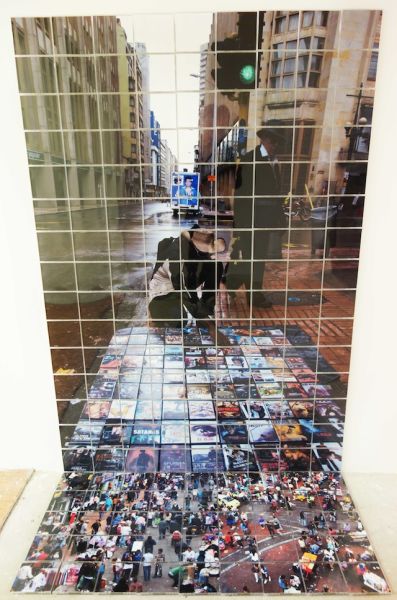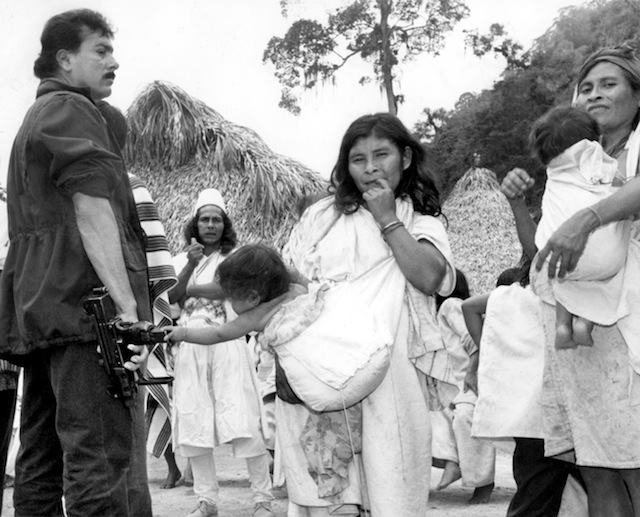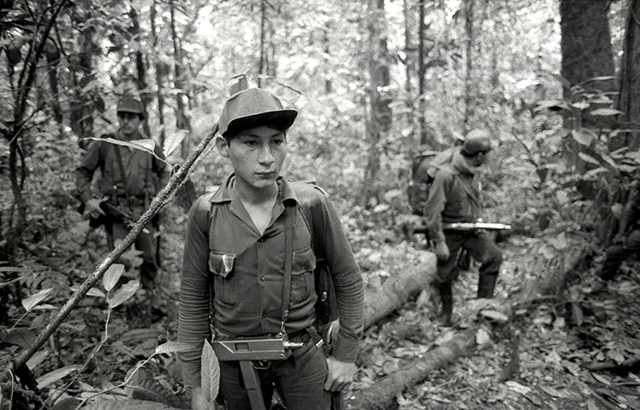Fourth World: Current Photography from Colombia at SF Camerawork presents the multi-generational work of four Colombian photographers, from journalists working in the 1980s to a conceptual artist born in that same decade. The exhibition is nominally about Colombian life in general, but decades of armed conflict, fueled by ideological differences and drug policies, govern Jaime Ávila, Zoraida Díaz, Luz Elena Castro and Andres Felipe Orjuela’s portrayals of the country.
One lively image of Colombian life is seen in Luz Elena Castro’s Guardians (1981), a black-and-white photograph of six young children smiling as they stand around a statue of a bloody and beaten Christ gazing heavenward. Grim religious imagery notwithstanding, the photograph captures a moment of apparent tranquility, one maybe only children are capable of enjoying.

This photograph, along with Jaime Ávila’s work, however, are rare examples of peace in an exhibit that more often depicts the country’s 50-year-long armed conflict. Most of Castro’s other works document soldiers, rebels, politicians and life under war.
Sacred Mountain (1993), a disturbing companion piece to Guardians, pictures a presidential bodyguard surrounded by women in a remote Andean town. A baby stretches from a sling to inquisitively reach for the guard’s submachine gun as if it were a toy.
The marriage of violence and childhood is made more clearly in Zoraida Díaz’s series of documentary-style photographs. In one, a boy draped in an oversized sweater smiles as he points a gun, possibly a toy, in the viewer’s direction. His puffed cheeks suggest a moment of joy as he plays desperado.

Two children run alongside an armored vehicle in Jugando a las Carreras (1988) while a man gripping a mounted machine gun looks askance at them.
For a boy in another one of Díaz’s photographs, conflict is much less of a game. Only a teenager, he is seen in a jungle wearing battledress with a gun at his side. It is unclear whether he is in training or combat, Díaz captures what could be either confusion or fear in his eyes.
While Castro and Díaz’s small and intimate works are powerful, their dark subject mateer can be disheartening for the viewer. Andres Felipe Orjuela does not alleviate this situation, but through his work, scattered throughout the gallery, he strives to take some control over the narrative.

Orjuela reanimates large archival photographs of traffickers and victims of government violence by illuminating them with pigments, resulting in Technicolor-like reimaginings of Colombian history. This process makes it difficult to passively consume the images, resulting in reflection rather than unquestioning acceptance of media imagery.
All four artists emphasize the Colombian people, mostly setting aside specific casus belli or historical events. By doing so, they avoid sensationalizing the decades of conflict, often creating accounts of war that are more personal than encyclopedic.
At times, Ávila’s work feels out of place, but depictions of life outside of conflict are ultimately necessary if a less spectacular representation of Colombia is desired. Daily life does not cease during such long conflicts, and for Colombians like Ávila, who is the youngest in the exhibition, the on-going but ebbing conflict may be of dwindling preeminence to their national identity.















